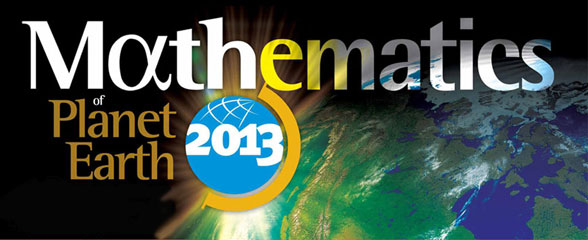 |
 |
 |
 |
 |
Conférences MPT2013 de la SMC - Résumes
Andrea Bertozzi (UCLA)
Conférence, University of Alberta, Edmonton, le 5 avril 2013(titre à determiner)
Gilbert Brunet (Environnement Canada)
Conférence publique à l'Université d'Ottawa, mars 2013Conférence publique, Memorial University, St. John's, mars 2013
The Mathematical Challenges of Earth-System and Weather Prediction
Internationally, the increasing demand for accurate high-impact weather and Earth-system (hydrology, chemistry, land, ocean, sea-ice ...)
predictions is indisputable. It has led to significant investment in sophisticated applied mathematical algorithms and studies,
high performance computing, high-speed telecommunication, remote sensing, ground-, space- and aircraft-based measurement technologies.
These has propped up fields and laboratory process studies, the development of observational techniques and coupled numerical weather and
Earth-system models to produce weather and climate predictions. At the dawn of this new century, significant applied mathematics,
research and development challenges remain to be met before acceptable meteorological and Earth-system forecasts with increase economic and
societal values can be produced worldwide from urban to planetary scale and all relevant time scale.
An historical perspective and future challenges of this multi-scale and seamless prediction problem will be presented.
John Bush (MIT)
Conférence à l'Université Laval, Québec, le 18 avril 2013Hydrodynamic Quantum Analogs
Walter Craig (McMaster)
Conférence publique, University of New Brunswick, Fredericton, le 10 octobre 2013Ocean Waves, Rogue Waves, and Tsunamis
Gerda de Vries (Alberta)
Conférence publique, University of Regina, le 7 février 2013The Language of Life: When Mathematics Speaks to Biology
Mathematics often is described as the language of science, particularly suited to speak to problems in physics, chemistry, engineering, and so on. Is mathematics also the language of life, suited to speak to problems in biology? Indeed, mathematics has a long and rich history in biology, and the reality is that today’s biology depends increasingly on data, algorithms, and models; mathematics plays an extremely important role in biology. In this talk, I will highlight some particularly noteworthy historical contributions of mathematics in biology, dating back to the late 1600’s, make connections to contemporary research in mathematical biology, and discuss how this research impacts our lives.
Darrell Duffie (Stanford)
Conférence, Fields Institute, Toronto, le 11 avril 2013The New Architecture of Our Financial System
Margot Gerritsen (Stanford)
Conférence publique, PIMS, Vancouver, le 14 janvier 2013How Does Google Google? The Math Behind the Internet
Conférence, University of Calgary, date à determiner
A Computational Mathematician Combusts: Simulation of in-situ Combustion for Heavy Oil Recovery
Nilima Nigam (SFU)
Conférence publique, CRM, Université de Montréal, le 15 février 2013Conférence publique, University of Manitoba, Winnipeg, date à determiner
The Mathematics of Light and Sound
Anthony Peirce (UBC)
Conférence à CRM, Montréal, le 18 mars 2013The Mathematics of "Fracking"
"Fracking" is used by the oil and gas industry to enhance the production of hydrocarbons.
Recently there has been considerable controversy surrounding the fracking process due to
environmental concerns. Fracking makes use of a process called hydraulic fracturing (HF)
by which tensile fractures are induced to propagate in brittle materials by the injection
of a pressurized viscous fluid. In this talk I provide examples of natural HF and situations
in which HF are used in industrial problems. Natural examples of HF include the formation of
dykes by the intrusion of pressurized magma from deep chambers. They are also used in a multiplicity
of engineering applications, including: the deliberate formation of fracture surfaces in granite quarries;
waste disposal; remediation of contaminated soils; cave inducement in mining; and, as mentioned above,
the fracturing of hydrocarbon bearing rocks in order to enhance productivity of oil and gas wells.
Novel and emerging applications of this technology include CO2 sequestration and the enhancement of fracture networks to capture geothermal energy.
I will show how dimensional reasoning can be used to identify the fundamental power-law
relationships between the variables depending on the balance between the dominant
physical processes that are active. I will describe the governing equations in 1-2D as well as
2-3D models of HF, which involve a coupled system of degenerate nonlinear integro-partial differential
equations as well as a free boundary. We demonstrate that a re-scaling of these models and dominant
balance arguments can be used to identify special asymptotic solutions that are of crucial importance
in the location of the fracture free boundary. I discuss the challenges for efficient and robust
numerical modeling of the 2-3D HF problem and some techniques recently developed to resolve these
problems, including: a novel Implicit Level Set Algorithm to resolve the free boundary problem;
an Extended Finite Element (XFEM) methodology for HF; and a Kalman Filter methodology to
identify the location of propagating fractures from remote measurements. The efficacy of these
techniques is demonstrated with numerical results.
Christiane Rousseau (Université de Montréal)
Conférence publique à l'Université Laval, Québec, automne 2013Mathématiques de la planète Terre
La Terre est une planète complexe, avec une atmosphère, des océans, un manteau animé de mouvements de convection. Elle est l’une des planètes du système solaire. Riche sur le plan biologique, elle est aussi façonnée par la civilisation. La vie est maintenant menacée par les changements climatiques et la surexploitation des ressources. Les mathématiques offrent des outils pour découvrir l’histoire de la Terre, explorer son intérieur, étudier ses climats, comprendre ses écosystèmes et l’organiser. À l’aide d’exemples, la conférence va illustrer le rôle des mathématiques dans l’exploration et la compréhension de notre planète, ainsi que les défis pour tenter de la protéger.
Jane Wang (Cornell)
Conférence publique, Fields Institute, Toronto, automne 2013Insects, Computers, and Us
Andrew Weaver (Victoria)
Conférence publique, PIMS, Vancouver, du 10 au 16 mars 2013An Applied Mathematician's Journey Into the Complex World of Climate Science
